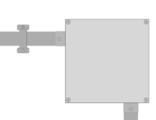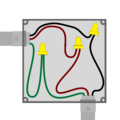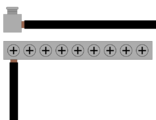Wiring practices
Jump to navigation
Jump to search
Wiring connects together all of the parts of a PV system. For wiring to function safely and for an installation to last, it is vital that it is installed according to its appropriate conditions of use and that it is protected against damage. One small error - loose wire strands at a connection creating a fault, a wire rubbing against the corner of a metal roof, insulation inserted into a connection - can lead to a system malfunction and potentially a fire. The following are some good installation practices that can help prevent system issues:
- If exposed to physical damage, a wire should be protected by some type of conduit or should be relocated. Physical damage can result from contact from persons, animals, or the environment. This also depends upon the type of wire as some wires and cables permit installation in wet locations or exposed to the sun.
- Wires and conduit should be adequately supported and secured to prevent damage and for good aesthetics.
- All wires should have extra length left in junction boxes or at any point where a connection is made. They should not have any sharp bends. This serves several important purposes:
- To prevent damage from the accidental contact with a person that may move the wire. An overly tight wire exposed to tension may immediately break free from its connection and cause a fault or fire.
- To allow for expansion and contraction of wire and conduit resulting from heating and cooling.
- To provide extra wire that enables safe working conditions in the future. Conector ciego con rosca
- All connections made with wire should be done with some kind of mechanical connection, like a Twist-on wire connector, busbar, terminal or PV module connector. Connections performed solely with electrical tape - as is common practice in many parts of the world - are far more likely to fail and cause issues.
- All wires that are entering a connection (busbar, should leave some conductor (copper) exposed to ensure that insulation is not entering the connection. Insulation in a connection can create resistance, heat and ultimately a fire.
- All connections should be tested with a gentle tug after being completed to ensure that the connection is solid and will not come undone easily.



